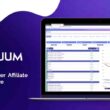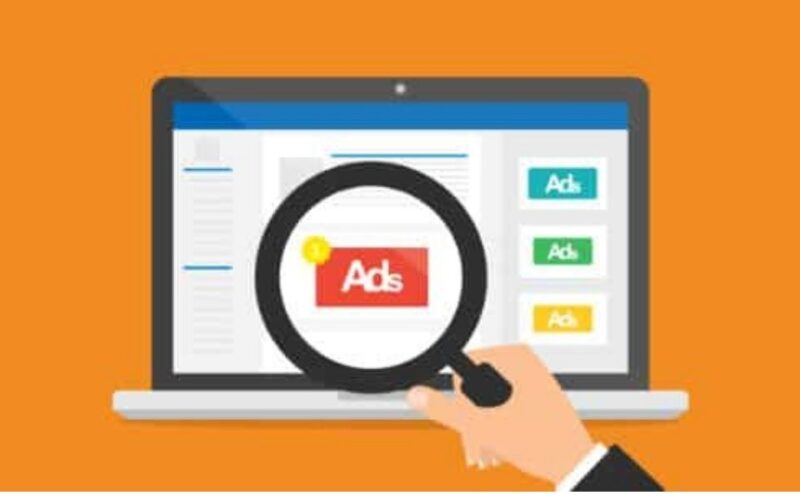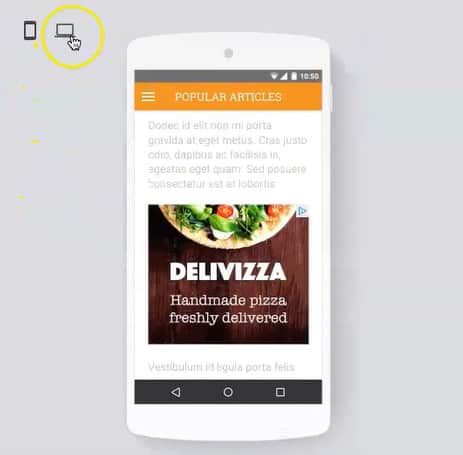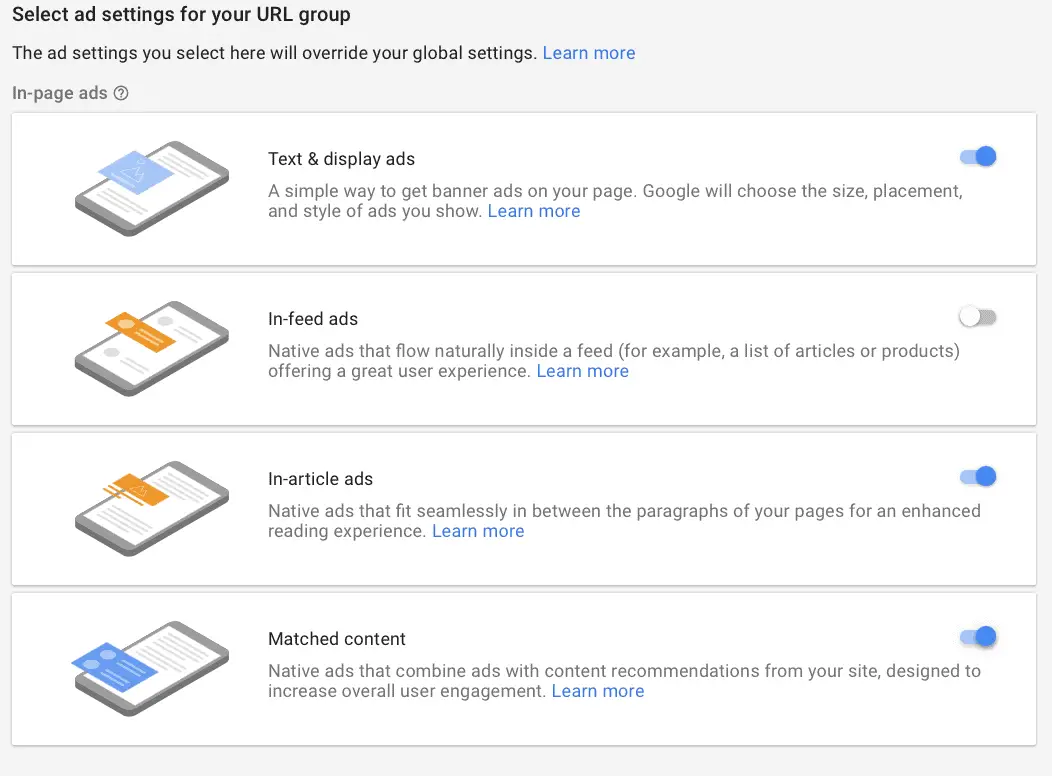Aside from sharing knowledge, the goal of every site or blog owner is to make money, and what better way to do it than to use Google AdSense on the website. Google’s advertising program was launched in mid-2003 and is currently the most popular advertising program on the Internet.
It provides a good opportunity for webmasters and site owners to monetize their traffic. Every year since then, Google pays over $10 billion to its publishers as earnings from ad revenue.
For new websites, blogs, and YouTube channels, the Google AdSense program is one of the fastest ways to generate income. This largely explains its popularity. Google AdSense on websites is a great monetization option that bloggers can use to monetize their traffic. Make no mistake, the Google AdSense program is not a get-rich-quick plan and requires work on the side of site owners.
In this article, Daniels Hustle is going to examine how to earn with Google AdSense on websites.
What is Google AdSense?
Google AdSense is an advertising program that allows owners of blogs to run ads on their website or blog and get paid when visitors click on them. The ads are generated from businesses that use Google’s AdWords program. These ads are then fed onto your blog or website using a special AdSense code.
If you are a regular reader at DanielsHustle, then you know there are many ways to earn income from a website. And we have discussed a lot of them in our numerous complete guides. Many of these monetization methods require that you have significant traffic before you’ll make money.
This is where Google AdSense on the website is a good monetization option for beginners. It’s free and easy to add the ad code to your website.
Creating an AdSense Account
As easy as getting an AdSense account might seem, there are certain requirements that have to be met before getting approval. And not just anybody can get such approval. Google wants to maintain the integrity of its ad network and as such, only high-quality websites get approval.
Some basic requirements every publisher needs to adhere to include:
- 18 years old.
- Have an active Gmail account that’s not linked to an AdSense account.
- Have a website that meets all of Google’s terms of service.
- You need to comply with the Google program policies
In addition to the official requirements, some seasoned expert users have suggested that:
- Having a website with at least 30 pages of unique content
- The website should be at least three months old and generating some traffic.
Usually, publishers get accepted within 24-48 hours, but it can sometimes take up to 1-2 weeks to get approval. Generally, the more traffic your website generates, the greater the chances of ad clicks and the higher your earning potential.
How Google AdSense Work?
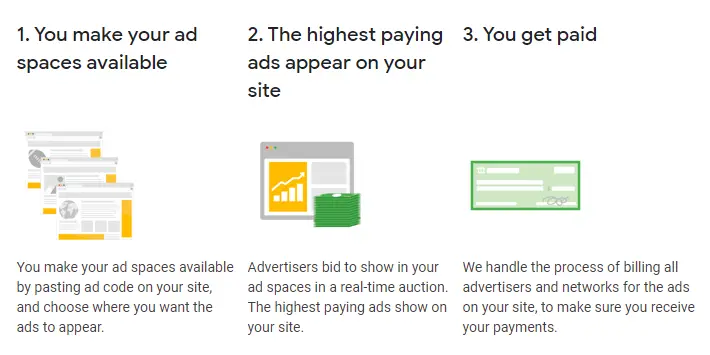
Google AdSense on websites works on the premise of you using your platform to display ads to an audience who then interact with the said ads. Quite simple!
Website owners create an AdSense account, then insert a small code into your website pages and you are ready to go. Google AdSense on your website will then display targeted ads on your page that are relevant to the content of your website or to your audience’s previous searches. This is done based on Google’s proprietary algorithms.
Whenever an audience on your site interacts with the ads by clicking, you will be paid a certain amount. Google AdSense works on a cost-per-click and revenue-sharing basis. This means that the more clicks you can provide, the more you earn.
Understanding Types of AdSense Ads
On getting approval, the next step is to start placing AdSense ads on your blog to earn ad revenue. Before we go into that, let’s examine the different types of ad units. Google AdSense on your website offers a wide variety of ad types to run on your blog. They include:
Display ads: This type of ad works excellently almost anywhere on a website page and is compatible with AMP (Accelerated Mobile Pages).
They can be responsive and automatically adapt to the screen size of the device where it’s being served. It can also be configured to have fixed sizes.
In-feed ads: This type of ad fit into a feed, a sidebar, or a list. They flow naturally in feed and enhance user experience.
Link ads: Ads in this format are text links that can be responsive or fixed size. It displays topics relevant to your page content.
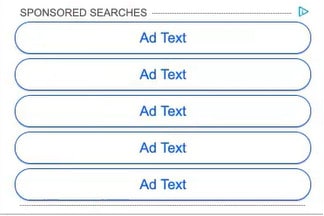
In-article ads: this type of ad fits within the content of an article without interrupting the reading experience.
Matched content ads: This type of ad recommends your blog content to the audience.
This in turn helps increase the number of page views by the audience as well as user time on the page. Since the audience spends more time and views more pages, this increases the chance of them clicking on your ads.
AdSense for Search: This allows you to have a Google search box on your website or blog. When a user enters a term and conducts a search, a search results page opens with AdSense ads. You can customize the color scheme of the search results page to harmonize with your website.
Starting Off With Your First Ad Unit
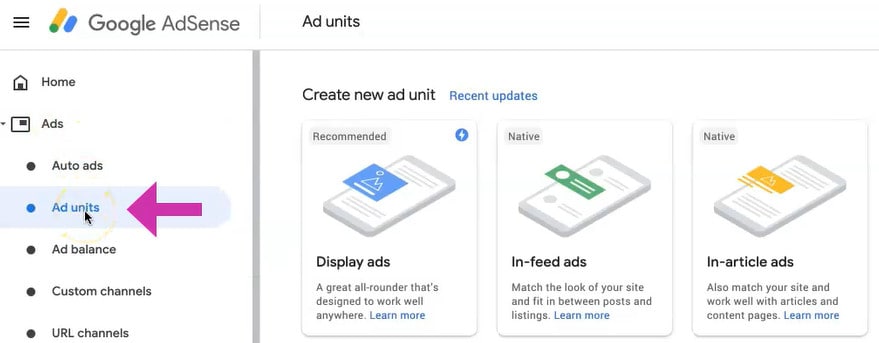
An ad unit simply refers to the advertisement space within a web page or mobile app where you display your ads. To display ads from Google AdSense on the website, you need to create an ad unit first. After which you can then add the code wherever you want the ad displayed on your website page. Once that is done, ads are displayed according to your specifications and you start earning.
Ad units are for AdSense publishers who want full control over the placement of their ads. Ad units basically submit control of ad types, ad sizes, and position of ads to the site owner. Creating your first ad unit is exceptionally easy. There are many ways of adding ad units to your website.
And depending on the website platform you use, you might need to edit the website code to add your ad units. Some platforms have built-in functionality that supports ads and makes it a lot easier to add your ad unit code. Some platforms like WordPress, provide different plugins, website widgets, and site-wide settings through themes that you can use to display ads.
Starting off with Auto Ads
The Google AdSense on the website provides Auto ads which is a quick and easy way for website owners to start running ads on their platform. Basically, Auto ads are automatic and Google will choose the most effective ad placements for ads to show up.
This implies that users are submitting the control of ad placement to Google’s machine learning tool. Although AdSense Auto ads can’t override or replace any of your pre-existing ad units, rather, it serves as an extra revenue stream.
To use the Auto ads, there are two settings that users can apply:
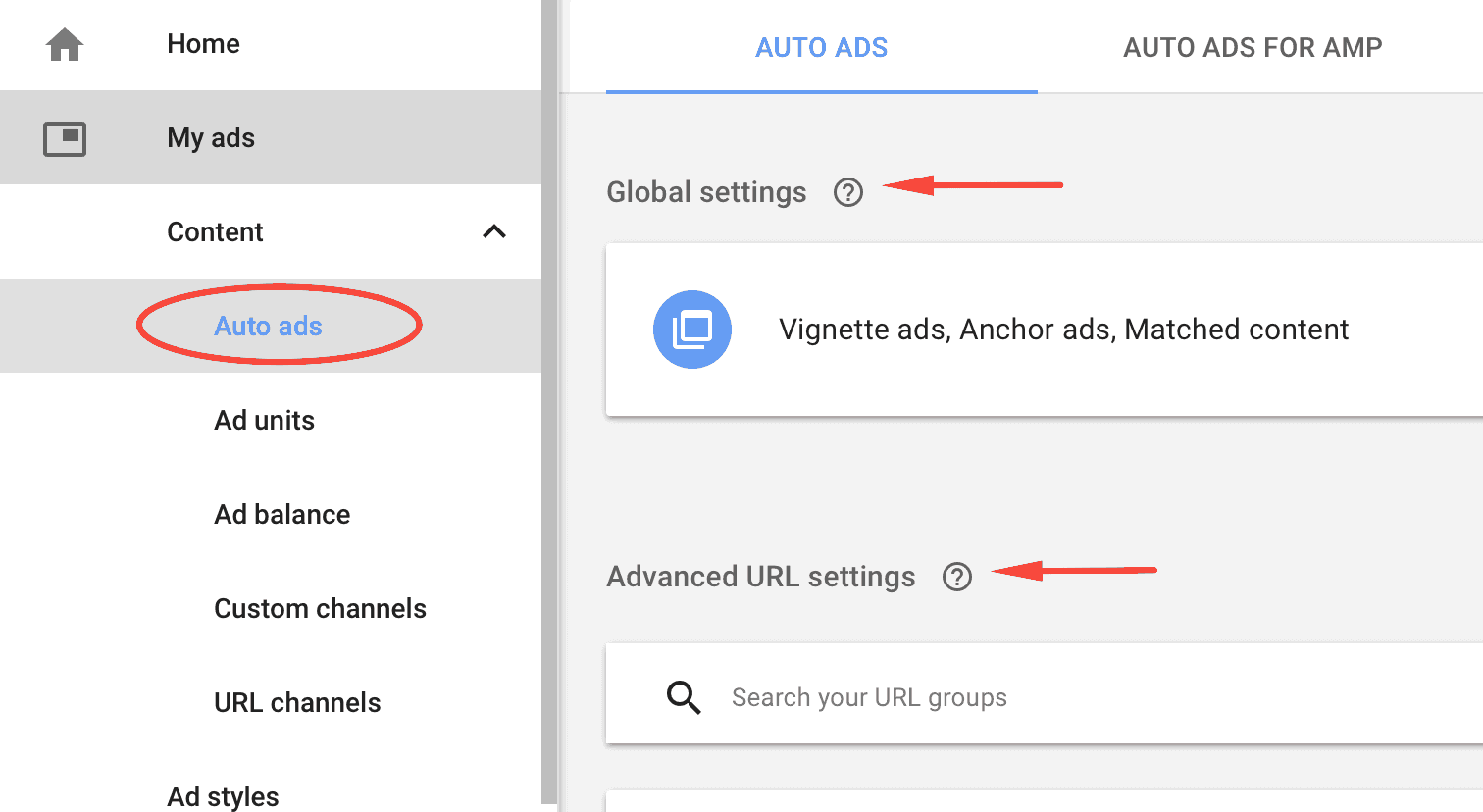
Global settings: This setting allows users to set how ads appear for the entire website.
Advanced URL settings: allows you to override the global settings and select ad formats for specific pages. If you have all the ads activated under the Global settings but wanted to exclude In-feed ads for specific pages, you can use this setting.
AdSense will comply and ensure that only the ad formats you allow are eligible for display.
Making Money with Google AdSense on website

Making money from Google AdSense on websites takes time. It may take days, weeks, or even months before you start to see an appreciable rise in the number of ads click. Earning money with Google AdSense on websites requires a plan, time, patience, and lots of optimization procedures.
A few basic tips for maximizing AdSense revenue include:
- Reading and adhering to Google’s rules. Bloggers must comply with all Google’s webmaster policies as well as the AdSense program policy.
- Incentivizing clicks, buying Pay Per Click (PPC) space, or the use of programs designed to drive traffic to AdSense pages are against the rules. Also, don’t ever click on your own ads.
- Create valuable and useful content for your audience. At the end of the day, your earnings are determined by how valuable your contents are to the audience. Valuable contents dictate traffic which in turn determines earnings
- Always use honest, organic traffic-building website marketing techniques such as Search engine optimization and article marketing. These are effective in driving free traffic to your site. And are totally acceptable by Google.
- Mobile users account for over 80% of traffic on websites and blogs. You don’t want to miss out on this. Therefore, optimize your website and make it responsive to mobile users.
Some technical tips include:
- Always use responsive ads. This works hand in hand with mobile responsiveness. Using responsive ads ensures that Google can send appropriate ad sizes to mobile devices visiting your site.
- Test ad types and placement to find the best fit options that increase earnings. You can begin with the regular standard sizes (300×250, 728×90, and 160×600). Then switch them, later on, to see if one size leads to more clicks than the other.
- The fold is the section of your page that is viewable without scrolling. You can place ads above the fold.
- Instead of putting an ad at the very top of the page, you can create a leader board ad below your header or logo. This increases visibility and the chances that it will get more clicks.
- Use in-content ads within your articles. This can greatly increase clicks since they are readily visible during the process of reading a post.
- Google AdSense on the website has various tools and feedback mechanisms to help you analyze your data. Make use of these tools to see what’s working and what’s not. Where deficiencies occur, make necessary adjustments to get the most out of your effort.
- Read emails from Google. Google regularly sends warning about things it doesn’t like on your site. Not reading your emails means you don’t get to know about these complaints. This can lead to the termination of your participation in the program.
Advanced AdSense Tips
As soon as you have ads running on your blog, it’s always a good practice to ensure that you are getting the highest value of your Google AdSense on your website program. Here is a list of more technical tips to consider when you’re ready to increase your ad revenue:
- Custom channels provide an optimal view of actions; it shows clearly what’s working and not working.
- AdSense allows you to run experiments or A/B tests on your ads.
- Certain color appeals to humans differently. You can experiment with link and box colors to see if it impacts results.
- Enabling placement targeting allows advertisers to choose where their ads appear on your website.
Google AdSense Payments
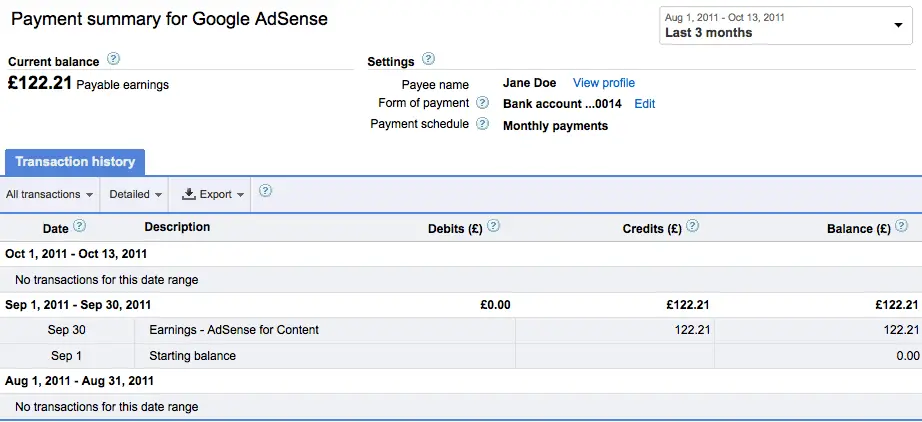
Users of Google AdSense on websites are paid via direct deposit or check. Although, the platform has a withdrawal threshold of $100. If you don’t earn up to the withdrawal threshold in a month, your earnings automatically roll over and are added to the next month’s earnings.
Each time you attain the $100 threshold, Google issues payment on the next payment period. From your AdSense account, you can access your current earnings; see which ads are generating the most clicks and other useful data.
However, when sending payments to your account from a different currency, Google converts it to your local currency. This is usually done at the standard exchange rate and sends it to your bank account.
Note: There is a possibility of a mark-up being added to the conversion rate, either by Google or your local bank. This means that you would lose some of your money when receiving payment from AdSense.
Optimizing Ads
Placing ads just about anywhere on your website won’t guaranty conversions for you. You need to know how to optimize such ads in terms of placement, size, number of ads per page, and even color. Optimization techniques help you attain the most value for each ad and can drive an increase in your ad revenue.
Quality of content
No questions asked, content is king. And if you intend to earn via an advert on your site, you will ensure to have quality content. Before audiences can come to your site to click on ads, they have to be attracted by the usefulness of the content you create. To measure the performance of your contents, run a Google Analytics report and observe the following:
- average user time on page
- pages per session
- bounce rate
All these are key performance metrics of your site’s content quality. When your audiences are not engaged, there is no way they can engage your ads. Review these metrics and optimize deficient indicators.
Ad Placement and Ad Size
Every site is unique and knowing where to place ads is as important as the money you seek to earn. The placement of ads is determined by the kind of site you operate. But here are some recommended placement techniques:
Desktop
Over the years, there’s been a decline in the amount of traffic coming from desktop users. But that doesn’t mean you can afford to neglect them. To optimize your ads for desktop, consider some of these:
Header section or Above the fold

Recommended sizes are 970×250, 970×90, 728×90, 728×250
Content area

Recommended sizes are 728×90, 728×250, 300×250, 336×280
Sidebar

Recommended sizes are 300×600, 300×250, 336×280, 160×600
Anchor/sticky

Recommended sizes are 728×90, 970×90
Mobile
Optimizing your site ads for mobile users is a compulsory component of earning money via Google AdSense on the website. Below are some proven sizes to get you ready:
For Paginated content, you can optimize your ads in this manner.
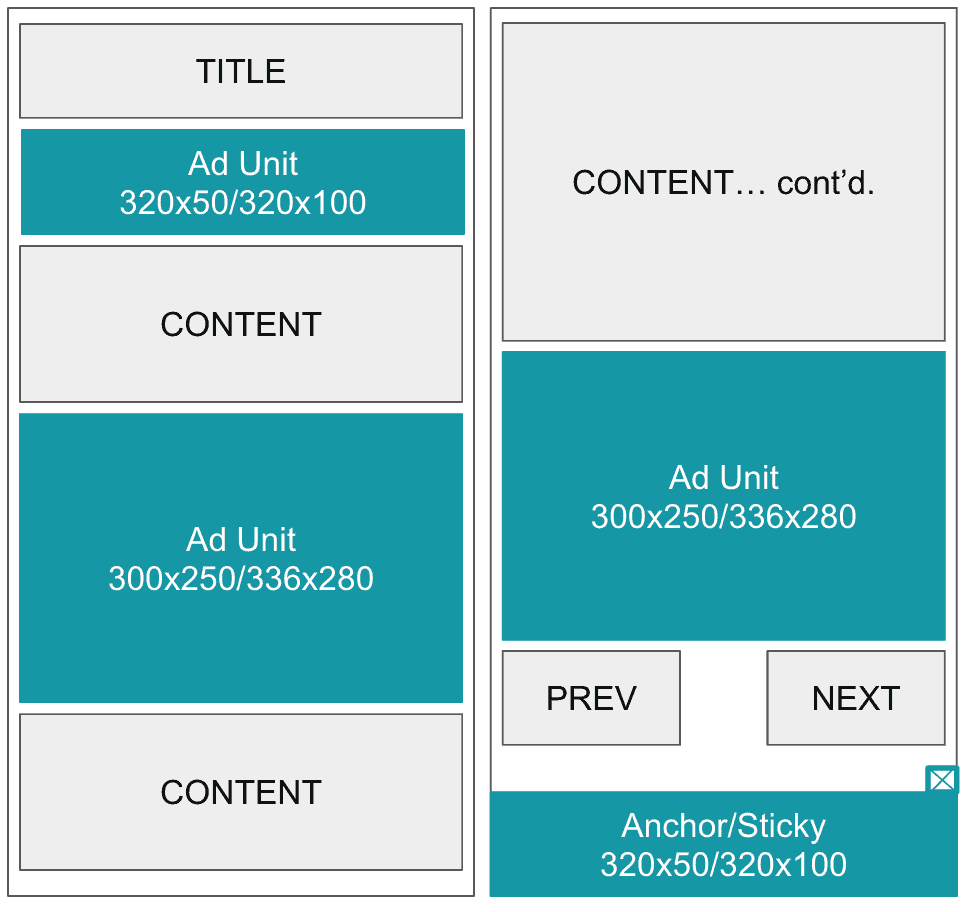
- one 320×100/320×50 after the title
- one 300×250/336×280 in-content
- one 300×250/336×280 before pagination button
- one 320×50/320×100 sticky bottom anchor (optional)
For websites or blogs with long-form articles or that are not paginated, you can optimize your ads in this manner.
- one 320×50/320×100 after the title
- one 300×250/336×280 every screen height
- one 320×100/320×50 sticky bottom anchor (optional)
Site speed
According to Google’s research, 53% of mobile web visitors leave if a webpage doesn’t load within three seconds. And since mobile users are increasing by the day, you want to optimize for them.
Number of ads to run
This has always been a perpetual question on the lips of site owners, how many ads can I run per page? The answer, there is no perfect number. Although Google AdSense on the website has lifted its restrictions in terms of the number of ads/page, they still recommend at least a 50:50 split of ads to content.
Naturally, sites are expected to have fewer ads than content, but never more ads than content. We at DanielsHustle believe the perfect number lies between 3 and 4 ads per page. Anything above this range will cause your site performance to drop. Audiences come to your site to digest quality information and not to be plagued by ads.
Another side effect of excess ads is that you earn less. Remember the Law of Diminishing Returns, well which applies to this instance as well. Competition among buyers becomes relaxed and CPM drops. This is because too many ad slots flood buyers and they still get the opportunity to display their ads. For far less than the usual fee!
To use or not to use Intrusive ads such as outstream
Sometimes, users of Google AdSense on the website can rely on Intrusive ads such as outstream as an extra source of revenue generation. But be careful, it can also affect your other ad units negatively. When intrusive ads cover other ads, there is a significant drop in viewability and Click-through Rate (CTR) for the covered ads. Also, CPM reduces.
If you intend to run non-standard ads, start slowly. Start with one per time and constantly monitor its performance.
Pros of earning with Google AdSense on Websites
- It’s free to join.
- Eligibility requirements are not tough although the program strives to maintain a high quality of blogs entering it.
- There is a variety of ad options and several that you can customize to fit in tandem with your site.
- Google pays monthly by direct deposit when you attain the $100 threshold.
- You can monetize several websites with ads on one AdSense account.
- You get paid for running ads on mobile devices and RSS feeds.
- Google AdSense works across websites, bloggers, and YouTube accounts.
Cons of earning with Google AdSense on Websites
Google AdSense on websites has its own drawbacks. And just as we have examined its advantages, we will now examine some of its disadvantages:
- Requires a steady flow of traffic in order to earn money. Just as it is with other forms of online income.
- Google can terminate your account in an instant if you break its rules. Getting such accounts back is a herculean task.
- When people click on an AdSense ad, you make some money; the downside is that visitors also leave your site. This can result in a loss of potential opportunity to make money with higher-paying affiliate products or from sales of your own products and services.
- A policy change by Google is a constant event. And not all changes will favor you or your site.
- Google AdSense on websites pays about the same rate as other similar ad programs.
Conclusion
Using Google AdSense on the website to earn is a pretty much decent monetization method. It’s easy and getting into the program is not that difficult. The amount you earn is dependent on many factors which we have discussed in this article.
Create quality content, optimize your website for mobile users, optimize your ads too and ensure to not flood your sites with ads. Also, a golden rule is to always play by Google’s rules, whatever you do, never run afoul of it.
There you have it guys, a comprehensive article on how to earn with Google AdSense on websites and blogs. Feel free to drop your question and comment in the comment section. We are sure to respond to them.


